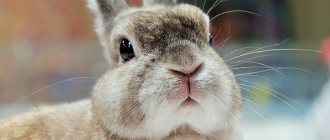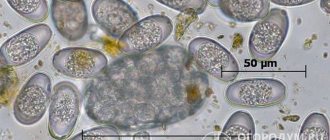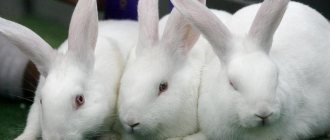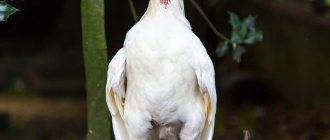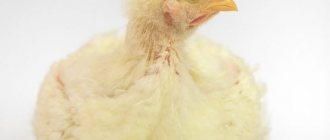Eye problems in a rabbit can occur for a variety of reasons. More often, this condition occurs due to infection, injury, or allergy. Farmers have a question: when a rabbit’s eyes fester, what to do? A special set of events is held at home for several days. Treatment is carried out only on the recommendations of a veterinarian.
The presence of pus in the eyes is a sign not only of conjunctivitis, but also of other, more serious diseases.
You can read about the vaccine for rabbits in our article here.
Rabbit eye anatomy
Large round eyes allow the rabbit to examine everything 360 degrees. However, the presence of fur and long ears narrow the radius to 30 degrees.
It is also believed that the rabbit distinguishes between 2 colors: green and blue. But it is more likely that the structural features of the eye make it possible to identify beams of light. Due to the shape of the head, the field of view from both eyes is layered on top of each other, reaching 27 degrees in the front and 9 degrees in the back.
The rabbit's eyeball is round in shape, it is surrounded by 3 eyelids: upper, lower, inner. The last eyelid is located in the inner corner of the eye. Under the fibrous film there is a gland with sebaceous secretion. The lacrimal gland itself topographically corresponds to the temporal angle of the eye. The muscular apparatus of the eye is represented by 7 ligaments: 4 rectus muscles, 2 oblique muscles, 1 for retraction of the eye.
The eyeball is open on all sides. Therefore, it is important to comply with the conditions under which the animal is kept. They monitor not only the quality, but also the quantity of the diet. It is also important to maintain conditions for the animal’s full functioning: treatment of cages, feeders, drinking bowls. If you raise rabbits outdoors, then proper placement of the cage plays a significant role.
Healthy rabbit eye
Conditions for keeping rabbits
The rabbit has a hard time withstanding changes in temperature and humidity. Therefore, it is recommended to adhere to a temperature of 13-17 degrees Celsius, and a humidity level of up to 70%. Sharp excesses in these parameters lead to heat transfer disorders in the animal.
When breeding rabbits in separate cages and common pens, it is important to prevent the penetration of drafts. Small but regular gusts of wind can cause an animal to catch a cold.
It is also important to follow daylight recommendations. Keep your rabbit in a place with direct sunlight, as this can lead to sunstroke. Short walks in the sun will not harm, but on the contrary, will strengthen the animal. When breeding on an industrial scale, sufficient artificial lighting must be created in the room from 6:00 to 21:00.
Preventive measures
Prices for cages for rabbits
Rabbit cage
Hygiene
It is very important to maintain good hygiene. Feeders should be cleaned regularly. When placing an animal outdoors, it is enough to clean it twice a week. In enclosed spaces, such activities must be performed daily.
The drinking bowl should be filled with clean water daily and replaced when dirty. Before serving feed, old food remains must be removed.
Prices for feed for rabbits
Compound feed for rabbits
The composition of feed depends on the season, as well as on the needs of the animal. In the autumn-winter period it is hay and mixed feed. In spring and summer, the emphasis is on vitamins and minerals. Young animals, as well as pregnant rabbits, require a more varied, nutritious diet. It is not recommended to serve freshly cut grass immediately; it is advisable to dry it a little in the sun before serving.
Good living conditions for the rabbit help prevent infections.
Possible causes of eye festering
The main eye problems that a farmer may notice in a rabbit are:
- frequent lacrimation;
- brown discharge;
- drooping eyelid;
- cloudy cornea;
- swelling of the eyelids;
- redness of the eyelids;
- protrusion of the eyeball.
There can be many reasons that provoke such conditions. They are associated with exo- and endogenous factors.
Dacryocystitis due to obstruction of the nasolacrimal duct
Table No. 1. The main reasons influencing the appearance of diseases and pathological conditions of the eyes in a rabbit.
| Violation of containment conditions | Infection | Injury | Allergic reactions | Avitaminosis | Anatomical features |
| Draft. Dust, debris and rabbit fluff in the cage. Dirty cage: presence of droppings and old food. Spraying chemicals near an animal. Lack of lighting. | Contact with infectious patients. The most dangerous myxomatosis is caused by myxoma viruses. Within a few days, myxomatosis can lead to the death of not only the sick rabbit, but also the loss of the entire livestock. | Injury to the nasolacrimal duct by dental hooks. To prevent the growth of these hooks, the animal is given special wooden rods. When these rods are chewed, the longest teeth are ground down. | Mostly occur on food. To identify the allergen, you should keep a food diary, and you can also take a sensitivity test. | Lack of vitamins and microelements. Conjunctivitis mainly occurs due to vitamin A deficiency. | Obstruction or partial patency of the nasolacrimal duct. If the discharge of lacrimal secretions is disrupted, dacryocystitis quickly occurs within a few days. |
The most common eye diseases in rabbits
Most often, eyeball diseases in rabbits are caused by infections, injuries, poor living conditions and allergies. Suppuration develops most quickly against the background of infections.
Conjunctivitis
Inflammation affects the mucous membrane of all 3 eyelids, as well as the sclera. The factors that cause conjunctivitis are varied. Redness of the eyes is the primary reaction to a cause of an exo- or endogenous nature.
Main symptoms:
- redness of the mucous membrane;
- lacrimation;
- pus in the corner of the eye and along the line where the eyelids close;
- swelling along the eyelid line;
- sticking of the eye.
The leading cause of conjunctivitis is staphylococcal, and less commonly, streptococcal infection. The ingress of even a small amount of microbes leads to rapid seeding and the appearance of suppuration.
The presence of pus and redness of the eyes are the main symptoms of the disease
Pasteurellosis
Pasteurellosis is caused by bacteria: Pasteurella bacillus, which is found in the upper respiratory tract. With any disease in a rabbit, the bacteria begin to multiply rapidly, primarily affecting the respiratory or digestive tract.
Through airborne droplets, the stick enters the rabbit's eye. Within a few hours, all signs of inflammation develop: fever (temperature up to 41 degrees Celsius), redness, swelling, purulence from the eyes and nose. The animal is apathetic and refuses to eat. All these signs are more characteristic of the acute form, in which death can occur already on the second day from the moment of illness.
Torticollis and lethargic behavior in a rabbit may be a sign of pasteurellosis
In the chronic form, clinical symptoms are less pronounced. A characteristic symptom is the appearance of torticollis. In the absence of intervention, after 2-3 weeks the animal dies due to toxins and exhaustion. At autopsy, areas of hemorrhage are found in the lymphatic tissue along the vessels. In chronic cases, pasteurellosis even affects the liver.
The disease is dangerous because it is transmitted from a sick animal. At the same time, all breeds of rabbits, birds, and other domestic animals can get sick. The risk of developing pasteurellosis is higher in young animals and pregnant animals. Rabbits with insufficient nutrition and poor living conditions are also susceptible to the disease.
Video - Rabbit pasteurellosis
Myxomatosis
Caused by the myxoma virus. Virus carriers: wild hares, pika, recovered rabbits. The virus remains in the blood for up to six months. The disease can be transmitted by blood-sucking insects. The peak incidence of myxomatosis occurs in the spring and autumn. It is then that the number of insects increases sharply.
The disease occurs in 2 forms:
- edematous: its manifestations are similar to conjunctivitis. The discharge is initially serous in nature, but on days 2-3 it is replaced by purulent discharge;
- nodular: the presence of a tumor ranging in size from a grain of millet to a pigeon egg. Located on the head, in the anus and on the genitals. After 2 weeks from the initial appearance, the nodules undergo ulceration and necrosis.
Nodular or nodular form of myxomatosis
Main symptoms:
- redness on the skin;
- temperature reaches 41 degrees Celsius in 1-2 days, then returns to normal;
- nodules of various sizes in places typical for myxomatosis;
- serous-purulent discharge from the eyes and nose;
- dyspnea;
- decreased appetite.
Rabbits quickly become infected from each other. The virus spreads in the blood, on the skin, in the subcutaneous tissue and parenchyma of internal organs.
With the edematous form, which lasts 2-4 weeks, death occurs in almost 100% of cases. For the nodular form, which lasts on average about 1.5 months, the death rate is lower and amounts to 70%.
Keratitis
Keratitis is clouding of the cornea due to an infection that causes inflammation. The disease is accompanied by suppuration, profuse lacrimation and the appearance of a film on the surface of the eye.
Keratitis is dangerous because it can quickly develop into an ulcer. After just 2 days from the onset of infection, the eye can completely drain.
Causes of sour eyes in rabbits
The most common cause is eye injury. A rabbit may accidentally run into a twig or blade of grass, and then begin to furiously scratch its face with its front paws. If dirt gets into the eye, inflammation will begin and, as a result, pus will be released. Timely first aid can protect you from this. The damaged eye should be examined and washed with a decoction of herbs. Chamomile or calendula, which are famous for their antibacterial properties, can cope with this.
You should not allow a rabbit to scratch its face, because contamination of the wound can cause sepsis and the animal will die. In some cases, you should even purchase a special collar for animals, which is sold at any pet store.
The second reason why a rabbit's eyes turn sour is an infectious disease. A pet can catch a virus during a cold or allergy, so you should carefully monitor the living conditions of your decorative friend. If a rabbit has a stuffy nose, often sneezes and is not active, then most likely the rodent has a cold. Along with colds, unpleasant eye infections can also come to visit. Among them, the three most common are:
Conjunctivitis
Conjunctivitis is a disease associated with internal inflammation of the eye. The occurrence of the disease is facilitated by mechanical injuries, allergies, otitis media or colds. It follows that the cage should not be in a draft, and the food must contain dust and sawdust. The most common symptoms of conjunctivitis are:
- redness of the white part of the eye;
- strong discharge of pus and ichor;
- swelling of the eyelids, inability to open the eyes;
- baldness in the corners of the eyes.
Conjunctivitis is treated with medications and frequent washing of the affected area with herbal infusions. If symptoms are noticed in a pregnant rabbit, you cannot treat the animal yourself; it is important to immediately consult a doctor.
The disease itself is not dangerous, but due to possible stress, the rabbits may die. Pain and discomfort weaken the furry ones.
Keratitis
Keratitis and conjunctivitis are considered paired diseases, but the first is still much more dangerous. Keratitis can also appear due to eye injuries or a cold, but most often it affects the eyeball if treatment for conjunctivitis has been delayed.
This disease is associated with inflammation of the cornea and covers the eye with an impenetrable film, narrowing the animal's visual horizons. Eye drops do not get under the film and it cannot be removed by washing. At this time, the infection begins to progress rapidly: a huge number of ulcers affect the white and pupil. If you do not intervene in time, the sore eye can leak out in a few days. The eyelids also swell greatly and the eyes stick together due to the dried crust.
If abnormal red dots become noticeable on the surface of the eye, you should not try to treat the animal, you should immediately consult a doctor. At this stage of the disease, only surgical intervention can save the rabbits. The symptoms of keratitis are not very different from conjunctivitis: cloudy discharge from the eyes appears, the eyelids swell and bright redness of the cornea forms.
An unpleasant consequence of keratitis can be a thorn that will remain with the rabbit for life. This is why you should contact a veterinary clinic at the first suspicion of such a disease: it is almost impossible to distinguish diseases by symptoms on your own. To prevent the disease, it is necessary to carefully examine the rabbits’ organs of vision and carry out eye prophylaxis.
Treatment tactics
The method of treating a sick animal is determined only by a veterinarian or ophthalmologist specializing in animal eye diseases. Self-selection of medications can lead to short-term improvement, and then worsening of the animal’s condition.
Instructions for the treatment of eye diseases
The volume of interventions depends on the type of infection and conditions of detention. In some cases, rabbits are vaccinated.
Step-by-step instructions for treating conjunctivitis
Step 1.
We take the rabbit out of the cage and assess the degree of damage to the eye.
Examine the rabbit
Step 2.
Preparation of the antibiotic: Ampicillin in an ampoule (1 million IU) is combined with 10 ml of saline. Draw 0.5 ml of the finished solution into a syringe.
Prepare the antibiotic
Step 3.
Eye wash.
Eye wash
Step 4.
Perform the procedure daily for 5 days. It is important to treat both eyes.
Both eyes need to be treated
Step 5.
If there is significant adhesion after rinsing, it is important to apply tetracycline ointment. A little ointment is applied to the outer corner, then distributed over the entire eye. If the second eye is healthy or there is no pronounced adhesion, then ointment is not applied to it.
Applying ointment
Also, to treat conjunctivitis in rabbits, a weak solution of potassium permanganate and 2% boric acid can be used. The procedures are performed daily for 5 days.
It is not necessary to prepare the solution yourself to treat the animal’s eyes. You can purchase ready-made antibiotic drops at the pharmacy.
If the rabbit has crusts, they must be softened before washing. To do this, use a solution of furacillin.
Video - Treatment of conjunctivitis in rabbits
Pasteurellosis
The animal is isolated and provided with a separate drinking bowl and feeder. The areas where the remaining rabbits are located are disinfected daily.
Anyone who treats a rabbit must comply with the following requirements: separate clothing, shoes, and safety glasses. Be sure to thoroughly sanitize your hands both before and after the procedure.
Treatment is symptomatic and specialized. To eliminate suppuration, the rabbit's eyes are treated with antibiotics. And vaccines are also administered: hyperimmune serum against pasteurellosis, terramycin and biomycin.
The best results are obtained from treatment of the chronic form. After recovery, the rabbit can be allowed to see other animals only after 2-3 weeks. Vaccination of healthy individuals can be carried out with specialized serum, starting from the 20th day of life.
Myxomatosis
Given the speed at which the infection spreads, treatment is effective only at early signs of the disease. This mainly concerns the chronic stage. The rabbit is given antiviral drugs. All nodules are treated with iodine to prevent secondary infection.
In any case, the animal must be isolated. The remaining individuals who were in suspected contact with the infected animal are given the vaccine. A combination vaccine made from the live B-22 strain of the myxomatosis virus and the inactivated B-87 hemorrhagic fever virus has proven itself to be effective.
Combined action vaccine
The vaccine in the form of a dry mass is packaged in sterile ampoules and containers. Vaccination can be carried out on all rabbits, including pregnant ones, starting from 1.5 months. Method of administration: intramuscular, intradermal and subcutaneous. A separate needle is allocated for each individual. Care and observation of the vaccinated animal is carried out for at least 20 days.
If vitamin deficiency is suspected, carrots, alfalfa, cabbage and fish oil should predominate in the food. The dosage of fish oil for young animals is 0.5 g/day, for adults 1.5 g/day. For pregnant rabbits and lactating rabbits up to 3.5 g/day.
Dacryocystitis is treated symptomatically. An impassable canal is pierced: with a syringe with an antiseptic, supplied under pressure, using a surgical method.
Keratitis is treated locally: drops with a non-steroidal anti-inflammatory component, an antibiotic and a protector. When an ulcer occurs, all non-viable areas are excised.
The most popular drops for the treatment of purulent eye diseases
Rabbits can also have the following eye diseases:
- cataract: clouding of the lens. The disease causes blindness. At the initial stages, they are treated with Quinax drops. If therapy is ineffective, the eyes are removed;
- Entropion of the eyelids: congenital defect. Corrected by surgery;
- uveitis: inflammation in the blood vessels of the eye. NSAIDs, antimicrobials and vasodilators are used for treatment;
- abscess: Depending on the location, extraction of the eyeball may be performed. If located externally, the abscess is opened and treated with antimicrobial drugs;
- tumor: confirmed after histological examination is treated surgically, supplemented by chemotherapy and radiation.
Treatment and prevention
Any attempt to treat the animal must be made in the early stages. To understand the exact cause of the disease and receive high-quality treatment recommendations, you need to seek help from a veterinarian. A long wait or an advanced viral disease results in the loss of the entire livestock.
Timely treatment can save the animal's eyes, and in some cases, life - do not postpone a visit to the veterinarian
When rabbits' eyes fester, it is necessary to remove the crust of dried discharge. To do this, use a clean napkin or gauze, which is moistened with diluted furatsilin at the rate of 1 tablet per 100 ml of water. It is allowed to replace it with a three percent solution of boric acid. The cloth is left on the affected eye for a few minutes to soften the crusts, and then gently wiped away.
():
The treatment is carried out in the direction from the outer corner of the eye to the inner (from ear to nose). If it is not possible to clean the eye at once, for each subsequent treatment take a new piece of cloth or a cotton pad soaked in the prepared solution. The procedure is repeated throughout the day as purulent discharge accumulates.
For mild forms of colds, the best medicine is infusions of chamomile, sage, and calendula, which are used to wash the eyes of animals three times a day. To consolidate the effect, a small amount of tetracycline ointment is placed behind the lower eyelid; if the patient’s condition worsens, two percent yellow mercury ointment is applied. It is allowed to instill drops with antibiotics.
If eye decay does not go away after 3-4 days, then a doctor’s consultation is necessary. He will make an accurate diagnosis and prescribe appropriate treatment. Basic actions for serious illnesses:
- For conjunctivitis, the eyes are washed with a two percent solution of boric acid, potassium permanganate, and rivanol. Foci of infection can be treated with instillation of sodium sulfacyl, chloramphenicol, sofradex and other drugs containing antibiotics. Enroflon is added to the food of rabbits, female rabbits and their offspring for 10 days as a strengthening agent.
- Uveitis is treated according to the form of the disease. Use drops or ointments containing antibiotics or corticosteroids. In advanced cases, surgery will be required to remove the lens.
- Treatment of dacryocystitis begins with stopping improperly grown incisors. Broad-spectrum drops are prescribed. Anti-inflammatory drugs for internal use are required, sometimes in the form of injections.
- Myxomatosis is the most difficult disease, which constantly progresses and creates new strains. It is impossible to fight it when the disease enters the active stage. In the nodular form, lesions that are not located on the mucous membranes are cauterized with iodine. They also wash the eyes and nose, use antibiotics and immunomodulators. The cure of livestock depends on immunity, therefore it is better to vaccinate twice a year.
Prevention is based on good living conditions. Pets should be housed in clean cages, protected from wind and temperature fluctuations. Their diet includes greens, branches, succulent food, which replenish the body's needs for vitamins, minerals and nutrients. If infected individuals are found, they are isolated. If deaths occur, the corpses are disposed of, and cages, feeders and drinking bowls are treated with formaldehyde or caustic alkali.
[dzs_videogallery]
General recommendations
To prevent the occurrence of suppuration in the eyes of a rabbit, it is important to comply with the conditions of detention. In the case of breeding, ventilation must be set up in production premises to ensure a constant supply of fresh air.
Wet cleaning should be carried out daily. The cells must be clean. It is recommended to completely clean the room once a week or whenever it gets dirty.
It is also important to maintain a balance of light according to the needs of a growing or adult individual. Nutrition should be complete and balanced. These simple recommendations are quite enough to prevent the appearance of pus in the eyes of a rabbit.
A rabbit's eyes are festering, how to treat it and the prognosis for recovery
For any purulent process in the eyes, treatment begins with determining the cause and prognosis of the outcome. Making predictions is difficult, but it is necessary to choose a treatment strategy.
- If the eyes fester due to myxomatosis, the prognosis is rather unfavorable. Ulcers very quickly form on the cornea of the eye, which leads to bilateral blindness in the rabbit, accompanied by pain.
- If there is pus in the eyes, especially if the eyes are festering in one eye, find the cause yourself. The purulent process can be caused by a microscopic splinter or a sharp seed, such as burdock. Purulent inflammation can be caused by dental reasons.
If you have difficulty identifying or eliminating the cause, contact your veterinary clinic. Often, to eliminate the cause (removal of a foreign body, tooth extraction), anesthesia must be used.

